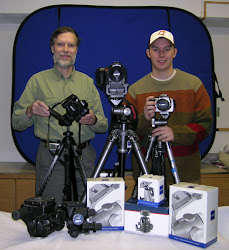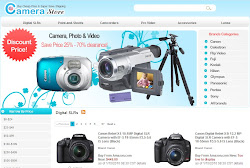Digital cameras come in various sizes, shapes, and specifications and offer a variety of impressive features.
Digital cameras are quickly gaining popularity around the globe. Many people already own one and routinely use it for their own pictures. Their use have become part of the culture among many communities and industries.
Digital cameras also have become part of a broad package of combined features with other hand-held tools, such as PDA devices and cellular phones. This makes the use of both devices much more convenient, having them combined in one, rather than two or more, functional instruments.
Digital Cameras, moreover, not only can be used for still photos as with conventional cameras, but also for taking videos. An owner needs only to upgrade the camera's memory card to increase storage capacity.
The marketplace offers a number of digital camera brands that provide a wide range of features. Olympus, Canon, Nikon, Kodak, and HP are some of the better-known brands of cameras offering the conventional 35mm to digital. Other key camera manufacturers include Sony, Panasonic, and Casio.
Digital Camera Considerations
Differing from conventional cameras, digital cameras have a small LCD screen, and sometimes an LCD screen plus viewfinder. The LCD screen is similar to TV screens that allow the photographer to see the picture, even before snapping it. Some have large screens that enable the photographer to see more of the subject and background.
Digital cameras also come with memory slots that hold a memory card or "stick"; the amount of memory available in them ranges from megabytes to gigabytes. Of course, the more memory, the greater the cost. However the extra storage capacity may be well worth the additional expense.
Another purchasing concern is the battery. Some digital cameras use disposable batteries. However, they wear out quickly, so most people recommend rechargeable batteries for longer energy life. Typically a rechargeable battery and a charger come in bundle with the camera unit.
Finally, consider the way the pictures are downloaded. Though many digital cameras come with a USB port which easily connects to a computer, there are others that necessitate removing the memory card and positioning it with a reader to download pictures.
Digital Camera Features
Camera buyers should know at least the basic features of their camera of choice before making an expensive purchase. Though the snapping of pictures is fundamentally the same from camera-to-camera, there are features that make one brand more appealing than others.
For example, the number of mega pixels used when taking pictures - meaning millions of pixels that help with the clarity of the pictures - should be one of the primary considerations to most buyers. Pixels are the individual "dots" that make up the content of pictures. As such, cameras offering a greater number of pixels can produce larger images with better resolutions than those with less. Be aware, though, that cameras using a more pixels consume more camera memory when storing the images.
The camera's zoom function is also critical. Most digital cameras are enhanced with a two-zoom capability; the optical and digital. Optical zoom uses a moving lens and makes the subject in the picture appear closer, while digital zoom crops or stretches the image.
Finally, don't neglect the importance of the camera case's durability. Some digital cameras are made predominantly of plastic materials - and are consequently more fragile - while others are comprised of a combination of plastic and metal alloy. Either type has limitations in the amount of jarring that can be sustained without internal damage. Spend a little extra money to purchase a case that will protect your camera investment.
For practical photography & camera information, please visit http://www.photography-and-cameras.com, a popular site providing great insights about photography training, camera types, and more.
Recommend : Cheap Handbags4u







0 comments:
Post a Comment